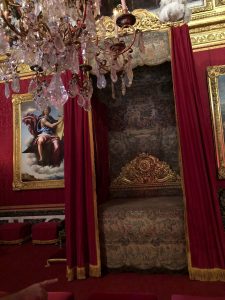Last Saturday, I visited Château de Versailles. It is supposed to be the most beautiful place in the whole world (Keith Easterling, personal communication, June 1, 2018).
At first, I certainly did not think that it was the most beautiful place, and it was not exactly what I expected. I did not look up photos of Versailles before visiting, so I had an unrealistic expectation. I have always had this picture in my head of what a royal palace should look like. I anticipated that, after I got off the train, I will spot a gold mansion across the meadow, under the sun, shining. But when I arrived at Versailles, it was cloudy, and the palace did not look very big to me at first sight.

I, personally, do not want to live in the palace of Versailles. The rooms, in my opinion, are over-decorated. The beds are also too small to fit me.

When I see the garden, however, I was astonished. It is mighty yet elegant. I spent more than two hours walking in the garden and visited almost every grove. I spent 30 min watching fountains water display at the “mirror pool.” If I become rich one day, I will build a garden that is similar to a grove in the royal garden.

I wish that I first approached the palace from the garden side. I liked the view from that side more. Do you know why? Whether I find something beautiful or not, that is, my aesthetic appreciation is supported by two networks in my brain: an initial network and a delayed network. Certain DMN regions’ activation connects to the delayed aesthetic network (Cela-Conde, 2013). You learn something every day!

What truly amazes me is how powerful Louis XIV was. The US has never had a king, and consequentially never a man so powerful to build such a magnificent villa. I wonder what makes him higher than everyone else, after all, he was only a human. As we know, classification is a crucial element and an unavoidable result of civilization. I wonder how our brains contribute to the process of classification. Utilizing fMRI, researchers identified VLPFC (ventrolateral prefrontal cortex) to be more active when receiving high-status nonverbal social cues. VLPFC is also proved to be connected to STC and VMPFC, which are suggested to be responsible for processing social information (Marsh, 2009). The activation of VLPFC of the 17th-century French people might contribute to their reverence to Louis XIV.
Reference
Cela-Conde, C., García-Prieto, J., Ramasco, J., Mirasso, C., Bajo, R., Munar, E., . . . Maestú, F. (2013). Dynamics of brain networks in the aesthetic appreciation. Proceedings of the National Academy of Sciences of the United States of America., 110 Suppl 2, 10454-10461.
Marsh, Abigail A, Blair, Karina S, Jones, Matthew M, Soliman, Niveen, & Blair, R J R. (2009). Dominance and submission: The ventrolateral prefrontal cortex and responses to status cues. Journal of Cognitive Neuroscience, 21(4), 713-724.
